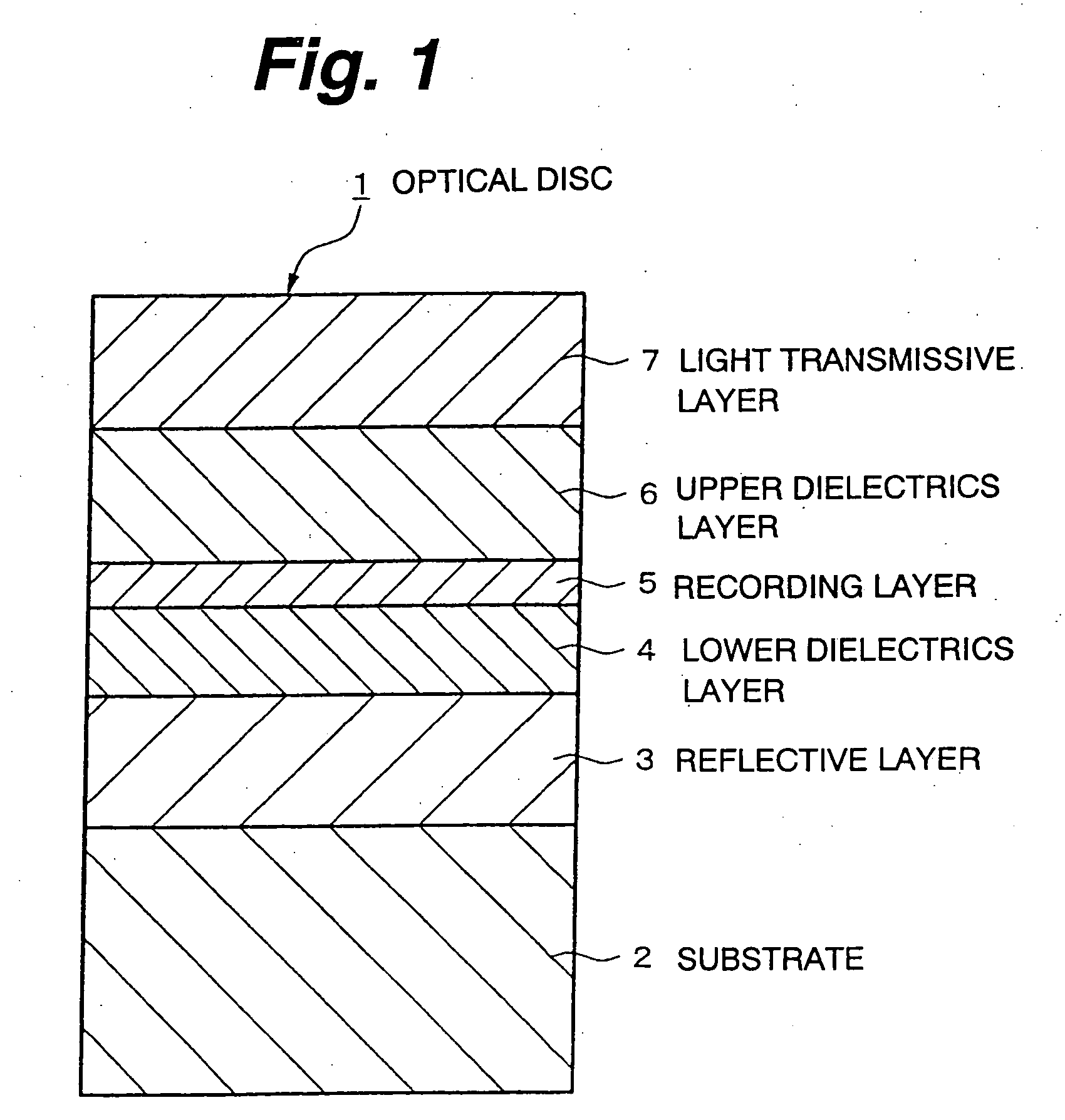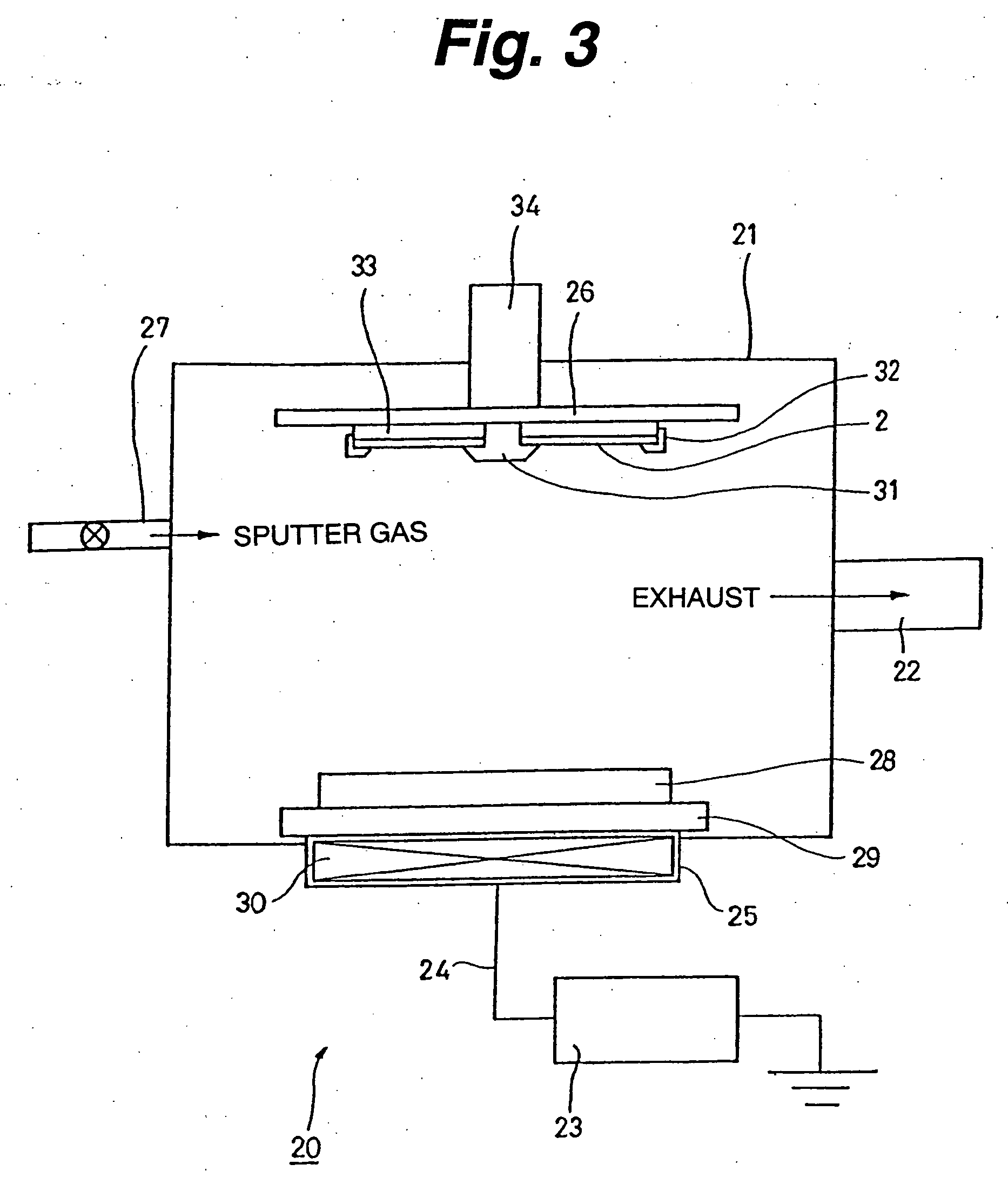Optical recording medium and method for manufacturing same
a technology of optical recording medium and manufacturing method, which is applied in the direction of data recording, record carrier material, instruments, etc., can solve the problems of inability to obtain excellent signal characteristics, inability to obtain high reliability, and inability to allow the disc surface relative to the optical axis of the optical pickup to tilt smaller, so as to achieve excellent signal characteristics and high reliability.
- Summary
- Abstract
- Description
- Claims
- Application Information
AI Technical Summary
Benefits of technology
Problems solved by technology
Method used
Image
Examples
examples 1 through 4
[0129] Examples 1 through 4 relates to optical discs formed by laminating, on a substrate 2, a reflective layer 3 made of AgNdCu, a second lower dielectrics layer 11 made of Si3N4, a first lower dielectrics layer 12 made of a ZnS—SiO2 mixture, a recording layer 5 made of GeSbTe, a first upper dielectrics layer 13 made of a ZnS—SiO2 mixture, a second upper dielectrics layer 14 made of Si3N4, and a light transmissive layer 7. The substrate 2 has a diameter of 120 mm and a thickness of 1.1 mm. On one main surface on a side on which the reflective layer 3 is formed, irregularities called grooves or lands are formed and a width of repetition of the irregularities (track pitch) is 0.32 μm. A content of Nd in the reflective layer 3 is 0.4 atomic percent and that of Cu is 0.6 atomic percent. Furthermore, the light transmissive layer 7 is formed by laminating a light transmissive sheet having a planar annular shape through an adhesive layer made of a pressure sensitive adhesive (PSA) coated ...
examples 5 through 8
[0143] Examples 5 through 8 relate to optical discs that are different from each other in thickness of the second lower dielectrics layer 11, and the thicknesses thereof are, in turn of examples 5 through 8, 4 nm, 8 nm, 14 nm and 18 nm. On the other hand, thicknesses of the respective layers other than the second lower dielectrics layer 11 are the same, and the reflective layer 3, the first lower dielectrics layer 12, the recording layer 5, the first upper dielectrics layer 13 and the second upper dielectrics layer 14, respectively, are 100 nm, 6 nm, 10 nm, 8 nm and 40 nm in the thickness. A thickness of the second lower dielectrics layer 11 was determined by properly adjusting a time based on a calibration curve obtained from relationship between a deposition time and a film thickness. Other than these are similar to examples 1 through 4.
examples 9 through 11
[0144] Examples 9 through 11 relate to optical discs that are different in thickness of the first lower dielectrics layer 12 from each other, and the thicknesses thereof are, in turn of examples 9 through 11, respectively, 4 nm, 10 nm and 12 nm. On the other hand, thicknesses of the respective layers other than the first lower dielectrics layer 12 are the same, and the reflective layer 3, the second lower dielectrics layer 11, the recording layer 5, the first upper dielectrics layer 13 and the second upper dielectrics layer 14, respectively, are 100 nm, 8 nm, 10 nm, 8 nm and 40 nm in the thickness. A thickness of the first lower dielectrics layer 12 was determined by properly adjusting a time based on a calibration curve obtained from relationship between a deposition time and a film thickness. Other than these are similar to examples 1 through 4.
PUM
| Property | Measurement | Unit |
|---|---|---|
| wavelength | aaaaa | aaaaa |
| wavelength | aaaaa | aaaaa |
| thickness | aaaaa | aaaaa |
Abstract
Description
Claims
Application Information
 Login to View More
Login to View More - R&D
- Intellectual Property
- Life Sciences
- Materials
- Tech Scout
- Unparalleled Data Quality
- Higher Quality Content
- 60% Fewer Hallucinations
Browse by: Latest US Patents, China's latest patents, Technical Efficacy Thesaurus, Application Domain, Technology Topic, Popular Technical Reports.
© 2025 PatSnap. All rights reserved.Legal|Privacy policy|Modern Slavery Act Transparency Statement|Sitemap|About US| Contact US: help@patsnap.com



